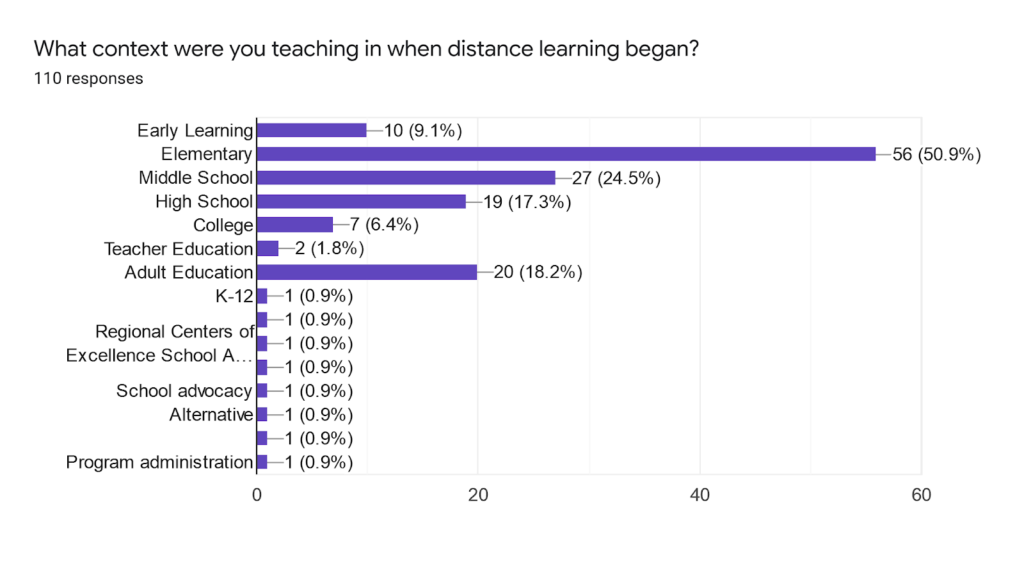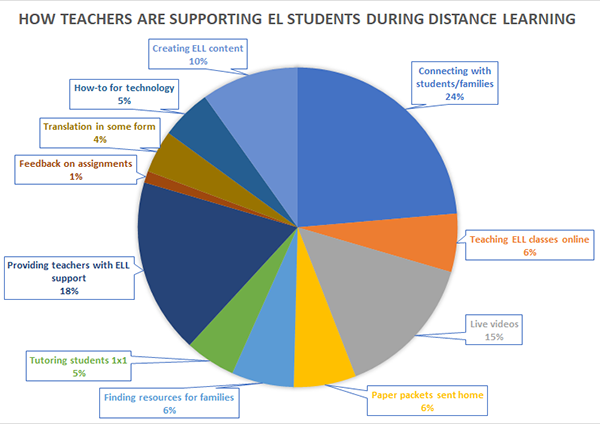Compilation from “Best Practices for Online Teaching & Learning in ELL Survey”
Sent by MinneTESOL from 4/24/2020-5/3/2020
Range of teachers represented (click image to enlarge)

How are you specifically supporting EL students during online learning

When asked “What would you say to educators right now about supporting multilingual learners in the online classroom?” this is a paraphrase of responses summarized by theme:
| # of Responses | General theme of response |
| 27 | Have patience (with the process and your students) |
| 26 | Create useful scaffolds to access content |
| 22 | Connect with families and students |
| 13 | Simplify everything, it’s overwhelming |
| 9 | Advocate for families in whatever they need |
| 7 | It’s challenging! |
| 3 | Remain flexible |
What ideas and strategies would you give ELL students and their families to help them be successful in online classes? (Both ELL or mainstream classes.)
- Make a schedule
- Ask for help
- Keep in touch with teachers who make things understandable for you
- Ask for things to be translated
- Don’t fall behind
- Don’t give up
- Keep practicing your English
- Keep practicing your home language
- Take breaks and go outside when you need to
- Do what you can, every day.
- Get yourself organized, try and find a quiet space to do school work
- Don’t be afraid to ask teachers for help
- Be patient with yourself
- Spread out your work, and complete it in chunks
- Work on the priority work first
- It’s okay if you don’t finish everything
- Ask teachers to provide more explicit instructions
What has been the hardest struggle for the ELL community in all of this, from your perspective?
| 42 | digital literacy or lack of access to technology |
| 20 | general overwhelm |
| 20 | lack of internet access |
| 19 | isolation |
| 18 | lack of consistent translation |
| 18 | difficulty getting in contact with families |
| 12 | families’ access to resources |
| 6 | financial instability |
| 5 | fear |
| 3 | parents working and unable to help much with school |
Some great informational resources that were shared with MinneTESOL through this survey:
- Distance Learning for Emerging Bilinguals: A Resource Guide for Teachers from Regional Centers of Excellence
- Distance Learning Best Practices for ELs from Melissa Lindquist at Prodeo Academy
- And the complied list of distance learning technologies
Memorable/Inspiring Quotes and ideas from Teachers
“…I would like to say that – even as we pare down what we can expect to cover and what we can expect from our students, we should also remember that classes are an important part of their lives right now. This is on several levels: They want to see and hear from us and “feel” our caring for them. They want to connect with their classmates. AND they still want to learn. Yes, for some it is too hard right now, but for many getting a chance to study a vocabulary sheet, or whatever, is a great distraction and part of what they really want to be doing for themselves and their future. Keep teaching!” – Debbie Hadas
Keep it as simple as possible! – multiple educators
“Keeping a school-wide spreadsheet for notetaking about daily contacts with each student.” – Roni Decker
“Don’t forget that the ESL teacher is a resource and can collaborate and support. Don’t neglect to share with them any information you learn about the student or their family situation.” – Valorie Arrowsmith
“OFFER EMPATHY – PATIENCE – GRACE – and really really try to keep in mind that if anything is/has been hard for us, as educators, it is going to be much harder and take much longer for our students and families to first learn, understand, and then feel comfortable using.” – Jillian Magnusson
“Try to take it one step, one day at a time. If one day is bad, start anew the next — it may surprise you.” – Debbie Therrien
“Be assertive about ELD as a priority for kids versus an add on service. I wasn’t and now the kids are paying the cost. It’s hard to go back and advocate for changes now.”
“Getting online now is hard for low literacy learners. Living at home with infected family members is stressful. But I think we need to look at what is easier, too. Women with children don’t need babysitters. Students don’t have long waits in the cold rain for the bus. Food, masks and gloves are provided by our city government. Many students actually have more work now than prior to the pandemic. Many students are able to study more and enjoy spending time with family. Students are learning to cook and play when they didn’t have time before. They’re sharing photos of their homes and family members. They are getting more pronunciation practice with online instruction. They are learning a lot of English.” – Nan Frydland
“There is no single story of the ELL community during this time. We are all uncertain, and we all have our own unique struggles. That said, one of the biggest things I see is lack of access to programs that used to support my families. ESL classes for adults are mostly cancelled or difficult to access online. People are losing their jobs. Domestic violence is on the rise because people are stuck at home, and the shelters are full. Even though my district has been able to get technology out to everyone, inequitable access remains an issue because different families have different access to the internet. But of course, I work with the greatest families and children on earth. I’m so lucky that I can still be connected to our shared community at this time.” – Dae Selcer
“…if anything, this pandemic will highlight for districts just how large this ‘advantage gap’ is and how different our home access to equitable education really is. Maybe now districts will see the value in hiring more culturally relevant staff to help support the unique needs of our multilingual families.” – Jillian Magnusson
Thank you for sharing with MinneTESOL!
Below is some detailed feedback from one teacher.
These are in order of ease of implementation and importance. If you are already doing things toward the top of the list, choose
something lower on the list to focus on!
- Nonverbals and pictures
- This is one of the easiest ways to emphasize and explain what you are teaching to students.
- Especially during distance learning when you are not in person, your nonverbal signals are even more important since you exist on a screen for students!
- Visuals in directions are also nonverbals. Showing a pencil at a spot where you want children to write, for example, is helpful.
- When using ASL, use www.handspeak.com to help with conceptual understanding
- Thoughtful teacher talk
- Make sure your rate of speech is slower than you would normally use in an in-person lesson so that students are able to understand you over video. This is important for students who have perhaps never heard the words you’re saying before in English (i.e. ‘nutrition’, ‘details’, or ‘fascinating trip’).
- Teacher language should be very clear. Now is the time to focus on your own enunciation of words.
- For example, I did not take the time to slowly say “biography” and “autobiography” in an introductory video so students’ pronunciation of those words has not been clear during the unit.
- Economy of language is more important than ever. With shorter lessons, slower rate of speech, and limited interactions with students, we must be particular about what we choose to say.
- When using definitions , consult the Learner’s Dictionary ( www.learnersdictionary.com ). This dictionary explains academic concepts in simple language.
- Clear what to do directions
- Just like in class, students need to know what to do for their independent work.
- Sequence the directions with numbers. Consider using visual keys that you can utilize across all lessons. (Ex:a pencil for where you want students to write, a picture of a thought cloud if you want them to think, etc).
- Keep it limited to 1 direction if your class is only able to follow one step directions
- Examples: 1. Watch the video or 1. Say your favorite food
- Keep it limited to 2-3 directions if your class is able to follow multi-step directions
- Examples:
- 1. Watch the video 2. Make a video saying what you learned
- 1. Watch the video 2. Watch the 2 links 3. Make a video: “I can help the Earth by ___.”
- Examples:
- Use as few words as possible. Now is not the time to introduce new vocabulary words, or write in long sentences.
- Use sentence frames so students know what to say (This Cinderella book is different from the other book because ___.)
- Leverage formatting to make it clear what students say. I always bold the words that students say in my directions.
- You can scaffold your use of these!
- For example, if there are 6 sentence writing tasks and you want your students to eventually write without support – gradually remove support throughout. #1 might be an example done for them. #2 and #3 might be sentence frames where they only have to fill in 1 or 2 words. #4 and #5 might be a shorter sentence stem, and #6 may be a free-write.
- Visual anchors
- These are things that students can access during learning that can make your instruction more “sticky.”
- Examples: sentence frame in videos and thumbnails (pictures that are the cover of your videos), posters, drawings in your actual instructional video
- Think aloud and live modeling
- Students need to be taught how to think , and the main way they learn that is from your words!
- Remember to talk out loud and say what you are thinking/doing and why you are doing it.
- Try to use the same way of doing this across all lessons. This will act as an aural cue for students. If you start all your think alouds with. “Let me check my thinking,” (or some other phrase), this will help students follow along better.
- Model how to do things physically in your instructional videos. If you are asking students to draw a reptile and label their body parts, show them an example in real time so they know how to do it.
- “Pause Points”
- Moments when the teacher tells students to pause the video and complete a task.
- These give the illusion of being in school and give students a clear task to do during the video.
- This allows for constant activity for students during a lesson and keeps them engaged.
- You may also include a visual here, like a stop sign and a pencil and paper (or a computer screen) to visually show what students should do.
- Think about how students will receive and process your lesson
- Think through your lesson from a student’s perspective . It may even be helpful to view your whole lesson as a student and go through the motions that you are asking of them. We don’t get to do this during “normal” school so take advantage!
- Examples:
- If you want students to click on the blue speaker on Flipgrid to read the directions to them, do that yourself and see what that is like to experience. Then adjust any of your language to make it more comprehensible.
- Watch your videos and do the verbal responses or math work you are asking students to do.
- Examples:
- Keep in mind all the best practices above as you watch and think about what you could adjust for the next time you record videos.
- Ask yourself whether you could complete this lesson in Spanish, Mandarin, Kayah, or a different language you sort of grasp.
- You could create a screencast or Zoom screen share from a student’s perspective that shows them how to navigate and complete tasks (daily assignments and assessments for older students).
- Follow predictable patterns across days and weeks. Following the same pattern each week helps students get into a rhythm and predict what will happen next.
- For example, in Ms. Selcer’s (EL teacher in Minneapolis, grades 2-4) class, there are the same 5 tasks each week: 1) ReadWorks assignment where children read/listen to a passage and answer questions, 2) video building background and vocabulary knowledge with a worksheet, 3) grammar focus with video, a video explaining the written practice, and then the written practice itself, 4) virtual hands-on learning that uses background knowledge, vocabulary, and grammar, 5) Flipgrid video where students discuss the week’s experiences.
- Think through your lesson from a student’s perspective . It may even be helpful to view your whole lesson as a student and go through the motions that you are asking of them. We don’t get to do this during “normal” school so take advantage!
